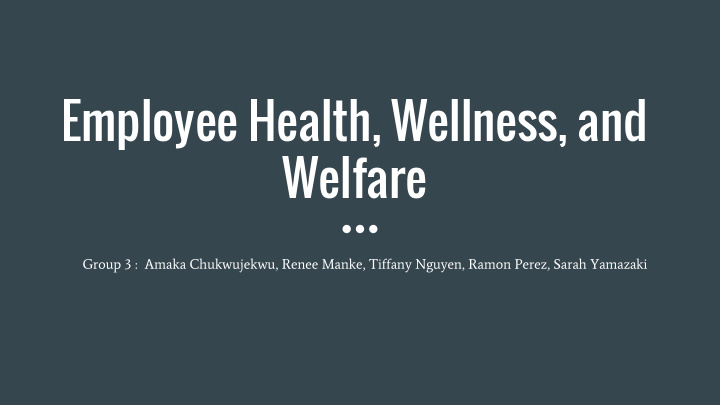



Employee Health, Wellness, and Welfare Group 3 : Amaka Chukwujekwu, Renee Manke, Tiffany Nguyen, Ramon Perez, Sarah Yamazaki
How Workplace Emotional Labor Harms Employee Home Life Sarah Yamazaki
Key Terms: ● Emotional Labor ● Surface Acting ● Emotional Exhaustion ● Work-to-Family Conflict 3
Grandey’s Model of Emotional Labor: 4
Sample, Method, Measures: ● Sample: 78 bus drivers 3 surveys per day (over span of 2 weeks) ● Measured: Surface acting, anxiety, work-to-family conflict, emotional exhaustion *Also measured emotional stability prior to study 5
Results: 6
Take Home Message: ● Job Autonomy ● Task Management ● C&B Package 7
Effects of Family-Supportive Supervisor Behaviors Tiffany Nguyen
Key Terms Family-supportive supervisor behaviors (FSSB) - consists of the dimensions of: ● emotional support ● instrumental support ● role modeling behaviors ● creative work family management 9
Key Terms ● Work-Family Intervention - refers to the training and application of FSSB ● WFC - Work-to-Family Conflict 10
Purpose Supervisor training and supervisor self-monitoring and how it can increase the supervisor's use of FSSB with the employees. 11
How study was conducted Train supervisor ● learned behaviors and how to apply them to all employees ○ Supervisors implement FSSB following training ○ behavioral self-monitoring ○ Surveyed employees pre-supervisor training and post-supervisor ● training (9 month period) 12
Sample Questions ● Emotional support (FSSB) ● Work-family Conflict ● Job satisfaction and turnover intent ● Physical health 13
Results 14
Improvement to Study ● Supervisors perceived negatively ● Work group is low income ● Specific Population 15
Take Home Message ● Focuses on those with higher family work conflict. ● Work it into company culture ○ Onboarding 16
Supportive Work Family Environments: Implications for Work-Family Conflict and Well-Being Renee Manke 17
Key Terms ● Work-family Conflict ● Work-family Culture ● Work Engagement ● Vigor ● Dedication ● Absorption 18
Research ● Sample of 112 employees ● A survey was assembled ● Participants completed online study 19
Model Relationship between family programs, work family culture, and work family conflict 20
Model 21
Take Home Message ● Invest and offer family-friendly programs ● Provide guidance on how to be supportive 22
Doing Good At Work Feels Good At Home, But Not Right Away: When and Why Perceived Prosocial Impact Predicts Positive Affect Ramon Perez
Key Terms ● Perceived prosocial impact ● Positive affect ● Activated Positive affect ● Deactivated Positive affect 24
Research ● Study was conducted by collecting diaries from: ● 68 firefighters and rescue workers twice a day for one week. ● Focus on within-person level ● Influence on-the-job behavior 25
Research (continued) ● The experience of helping others at work has spillover effects in predicting positive affect at home, and vice versa . ● Positive affect = positive mood = happiness = empathic (warmhearted) joy 26
27
Take Home Message ● Supervisors-employees interaction (aware of their contribution to team) ● Relates to high stress jobs (e.g., Police officers = burnout) ● Teach/Train to build daily routines of deliberately thinking about how we make a difference daily (Appreciate) ● Positive culture = happy employee = + Org value (No quitters) 28
Employee Adaptation to Feelings of Job Insecurity Amaka Chukwujekwu 29
Job Insecurity and Adaptive Behaviors Employees that experience job insecurity are likely to engage in adaptive work behavior including less use of work-nonwork support program. 30
Procedure and Sample ● Data collected from sample of 2,835 employees ● An online survey was assembled to assess their job insecurity. ● Participants were surveyed at two separate points. ● Purpose of the study was to better understand attitude toward work life balance and work-life. 31
Key Terms ● Work-Nonwork Support Program ● Work-to-Nonwork Boundary permeance ● Work-Nonwork Conflict ● Emotional Exhaustion 32
Results 33
Results Job insecurity ----- negatively related -------organization’s work-nonwork ● support programs.Job insecurity -----positively related ---work-to-nonwork boundary permeance. Organization’s work-nonwork programs and work-to-nonwork boundary ● permeability-----mediate the positive relationship between job insecurity ab work-nonwork conflict. Organization’s work-non-work support programs and work-to-family ● boundary permeability----partially mediate the positive relationship between job insecurity and emotional exhaustion. 34
Take Home Message Organization that wish to facilitate employee use of the support programs ● should clearly address their concerns relative to job insecurity. Human resources department should come up with a contract, which ● allows employees to use the work-nonwork program without any retaliation from the employers. Managers should also support employees that uses the program in other ● to minimize argument that will raise the issue of job insecurity. 35
Overall Take Home Message Consider the stressors of the job Understand needs of the company and the affect employee emotion has on themselves, and people that interact with them, whether it be a family-to- work conflict or work-to-family conflict. Reduce employee absenteeism, turnover, stress, & improve employee relations 36
Recommend
More recommend